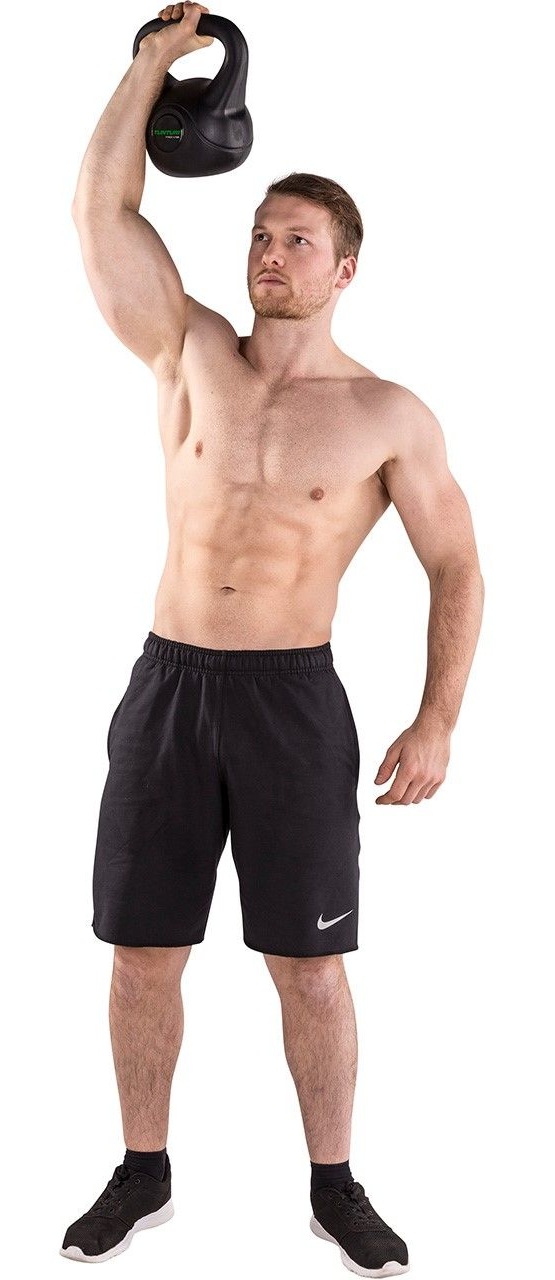Many people don’t have enough time to commit to regular full-body workouts at the gym. Additionally, gyms can be particularly crowded after work hours. This is where alternatives come into play. If you want to train intensely and flexibly alongside work and family, without leaving your home, a full-body workout with a kettlebell can be very effective. You may have heard of kettlebells but are unsure about which full-body exercises you can do with them. We will show you how to get started and how you can see noticeable results after just a few weeks. You only need 30 minutes and a bit of space at home for a full-body workout.
Weight and Form
Kettlebells are spherical weights with a handle and a flat base. They can weigh between 2 and 32 kg. For complete beginners, it’s recommended to use weights between 2 and 4 kg for a full-body workout. For women, weights between 6 and 12 kg and for men, between 8 and 20 kg are recommended. Weights over 20 kg should be reserved for advanced practitioners and professionals. Always ensure that you can perform your full-body exercises with proper form. If in doubt, choose a lighter kettlebell. Later, you can always increase the weight. It’s also important to wear sturdy and stable footwear during training. Never perform a full-body kettlebell workout barefoot or with lightweight running shoes, as your body won’t have enough support for the swinging and powerful movements.
Full-Body Training for Strength, Endurance, and Coordination
Kettlebells are highly versatile training tools. Unlike barbells, they don’t just build isolated muscles but work multiple muscle groups as well as tendons and ligaments at the same time. Full-body training boosts strength, endurance, and coordination. The body becomes more muscular, defined, and overall more powerful. If you want to lose weight, kettlebell full-body workouts are also highly effective. During an intense session, you can burn around 700 to 1,000 calories per hour. Additionally, muscles increase the body’s basal metabolic rate.
Creating a Full-Body Training Plan
While every training plan is individualized, there are a few basic principles to keep in mind. For full-body training, you need little space but should have enough room to move freely. Make sure you can swing the kettlebell without hitting anything.
Kettlebell Full-Body Training Plan – Duration
Set aside 30 minutes for your full-body workout. Spend 5 to 10 minutes warming up. You can warm up by jogging in place, using an ergometer, jumping rope, or doing jumping jacks, just to name a few. If you enjoy it, you can also go for a jog or brisk walk outside before your full-body workout. Anything you like that adds variety to your training plan is allowed.
Kettlebell Full-Body Training Plan – Training Days and Rest
For beginners, it’s advisable to do the full-body workout 2 to 3 days a week. Be sure not to schedule training days back to back, and always plan at least one rest day in between. This way, the full-body workout is effective without causing overuse or overtraining. Many people who start full-body training are eager to do too much too soon. Avoid this and instead take a slower, more thorough approach.
Kettlebell Full-Body Training Plan – Easy and Effective Full-Body Training
Below, we present 5 simple exercises that are easy to learn. They can be done by both beginners and advanced practitioners. Vary the number of repetitions and increase the weight as needed to add variety to your full-body workout.
Full-Body Workout – Repetitions and Rest
Perform 6 to 12 repetitions of each exercise. Afterward, rest for 1 to 2 minutes and then move on to the next exercise. Repeat this for all 5 full-body exercises. Later, when you’re more advanced, you can transform your training plan into a circuit. You can then repeat the entire sequence up to 3 times.
Swing
Stand slightly bent over and grip the kettlebell with both hands. Swing the kettlebell between your legs and then forward and back. Ideally, swing it back until it has clearly passed your legs. Swing it forward until you are standing upright with a straight back, and your arms form a 90-degree angle to your body. The swing is a true full-body workout as it strengthens the hips, back, shoulders, thighs, abdomen, and glutes equally.
6 – 12 repetitions

Goblet Squats
This is a squat with kettlebell support. Hold the kettlebell by the sides of the handle with both hands in front of your chest. Perform a squat while keeping the kettlebell in place.
6 – 12 repetitions

Row
This exercise is excellent for the legs, back, and biceps. Step forward into a lunge, keeping your back straight. Shift your weight onto the front foot. Hold the kettlebell in one hand and pull it up along your body, then lower it again. Repeat this on the other side.
6 – 12 repetitions per side

Thruster
This exercise trains coordination and strength. Swing the kettlebell up so that the handle is below your chin. Keep your arms close to your body and grip the handle tightly. The momentum is generated by the squat. Go down and then back up. You can increase the intensity by lifting the kettlebell overhead.
6 – 12 repetitions
Russian Twist
Sit with your back at a 45-degree angle to the floor. Swing the kettlebell from side to side under chest height and toward the floor. Your legs should be comfortably bent on the floor initially, but for more advanced practitioners, keep them off the floor. This is an excellent exercise for the oblique muscles.
6 – 12 repetitions per side

 isports Magazin
isports Magazin




